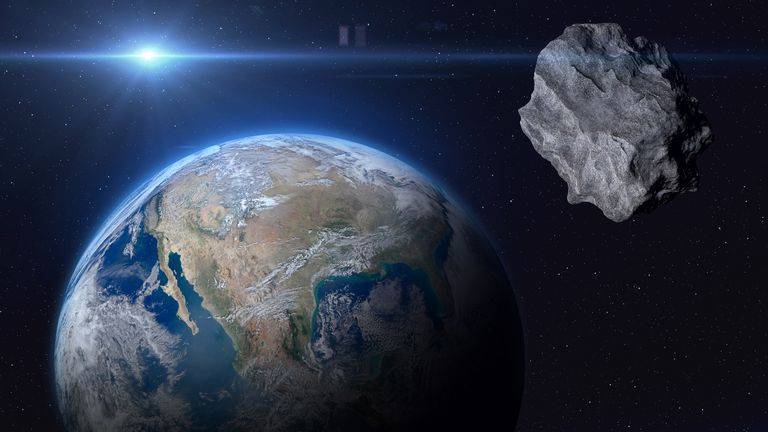The Asteroid Hits and Near-Misses You Never Hear About.
By Georgina Rannard, Climate and Science Reporter.
A large asteroid named 2024 YR4 has recently made headlines as scientists initially raised, then lowered, its chances of hitting Earth. The latest estimates suggest a 0.28% chance of impact in 2032, significantly lower than the earlier 3.1% probability. Instead, scientists now believe it is more likely to collide with the Moon, with NASA estimating a 1% chance of that happening.
Discovered two months ago through a telescope in Chile’s desert, 2024 YR4 has since been overshadowed by dozens of other objects that have passed closer to Earth than the Moon—a near miss in astronomical terms. Many smaller asteroids likely hit Earth or burned up in the atmosphere unnoticed.
This is the untold story of asteroids—fly-bys, near-misses, and direct hits. While most are harmless, some carry invaluable clues to unlocking the mysteries of our universe.
The Science Behind Asteroids
Asteroids, often called minor planets, are rocky remnants from the formation of our solar system 4.6 billion years ago. These rocks frequently orbit close to Earth, influenced by the gravity of other planets.
For most of human history, we were unaware of how close we came to being struck by large asteroids. Serious monitoring of near-Earth objects only began in the late 20th century, according to Professor Mark Boslough from the University of New Mexico. “Before that, we were blissfully oblivious to them,†he says.
Today, we know that objects 40 meters or larger pass between Earth and the Moon several times a year. For context, an asteroid of this size exploded over Siberia in 1908, injuring people and damaging buildings across 200 square miles.
The Apophis Comparison
The most notable near-miss was Apophis, a 375-meter-wide asteroid first spotted in 2004. Initially considered the most hazardous asteroid ever detected, it took until 2013 to confirm it would not hit Earth.
Professor Patrick Michel from the French National Centre for Scientific Research (CNRS) recalls the uncertainty surrounding Apophis. “We didn’t know what to do. We discovered something, determined an impact probability, and then thought, who do we call?†he says. At the time, scientists and governments had no clear response plan.
The Threat of 2024 YR4.
While 2024 YR4s exact size remains uncertain, estimates suggest it could be up to 90 meters wide. If it were to hit Earth, it might remain largely intact upon entering the atmosphere, potentially creating a crater and causing significant damage.
Professor Kathryn Kumamoto from Lawrence Livermore National Laboratory explains, “The surviving asteroid mass could destroy structures in the immediate vicinity and pose serious injury risks to people within dozens of kilometers.â€
Advances in Planetary Defense.
Since Apophis, significant progress has been made in planetary defense. Professor Michel is part of the Space Mission Planning Advisory Group, which advises governments on asteroid threats and conducts rehearsal exercises for potential impacts.
If an asteroid were on course for a populated area, the response would resemble hurricane preparedness, including evacuations and infrastructure protection. The group will meet again in April 2025 to assess 2024 YR4 , though most scientists expect the risk to diminish as trajectory calculations improve.
NASA and the European Space Agency have developed technologies to deflect asteroids, such as the Double Asteroid Redirection Test (DART), which successfully altered the path of the asteroid Dimorphos. However, scientists remain skeptical about applying this to 2024 YR4 due to uncertainties about its composition and the limited time frame for deflection.
The Silver Lining of Asteroid Impacts.
While a direct hit on a populated area would be catastrophic, a strike in a remote region could provide scientists with valuable insights. Nearly 50,000 asteroids have been found in Antarctica, including the famous ALH 84001 , believed to originate from Mars and containing evidence of the planet’s ancient water and warmth.
In 2023, scientists detected 33 Polyhymnia, an asteroid potentially containing an element denser than anything on Earth. Such discoveries highlight the scientific potential of asteroids.
The Moon as a Target
With 2024 YR4 now more likely to hit the Moon, some scientists are excited about the opportunity to study a real-world impact. Professor Gareth Collins from Imperial College London notes, “To have even one data point of a real example would be incredibly powerful.â€
An impact could answer questions about material ejection, speed, and distance traveled, helping refine models for asteroid impacts on Earth.
Looking Ahead
2024 YR4 serves as a reminder that Earth is vulnerable to collisions with the countless rocks in our solar system. Scientists warn against complacency, emphasizing that it is a matter of when, not if , a large asteroid will threaten human life—though most expect this to occur in the coming centuries rather than decades.
Our ability to monitor space continues to improve. Later this year, the Vera Rubin Observatory in Chile will begin operating the largest digital camera ever built, capturing the night sky in unprecedented detail. As our technology advances, we are likely to detect even more asteroids orbiting close to Earth.
This is the story of the asteroids we rarely hear about—silent travelers in our cosmic neighborhood, some carrying destruction, others the keys to our universe’s deepest secrets.


